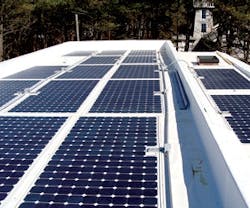In the late 1980s, the FJ Christiansen Roofing Co. of Milwaukee introduced an innovative leasing concept in which they would install an appropriate roof system on a building and lease the roof back to the building owner. Rather than use cash from the owner’s capital account, the roof would be expensed along with all other operating expenses on an annual basis.
This concept had many advantages. Christiansen Roofing would determine the best roof for a specific building, design it, install it, and maintain it. The firm would control new penetrations if needed for rooftop equipment, service the roof if hail damaged it, and determine when and if the roof needed to be replaced.
Building owners quickly discovered that the annual cash layout might be less than the expenses incurred when an owner must constantly make emergency repairs and/or has no reserves dedicated to roof replacement.
Today, economic conditions for building owners may be more critical than they were in the 1980s, but so are the opportunities.
Advanced Green Technologies (AGT) of Ft. Lauderdale, FL, announced a program that combines the financial component of the earlier concept with a new photovoltaic (PV) component that takes into account the energy challenges we now face. Photoelectric and other solar systems can be desirable if they perform as advertised; however, putting together electrical technologies, energy rebates, durability, maintainability issues, and energy codes is daunting.
AGT has partnered with financier CTC Resources Inc. to offer financing with no down payment, 0 percent interest, and no payments for the first 3 months after installation of a roof with PV panels. If the PV system performs as expected, the new roof provides a monthly payback by reducing purchased power as well as refunds for excess power returned to the grid. Solar power may also generate carbon credits with a cash value.
Navigating the rebate market requires professional help. Financial incentives are temporary, and the design and installation of the solar roof must meet the required time limits as well as other criteria.
Most roofing professionals believe it makes little sense to install solar panels on roofs that are near the end of their lives. With the construction traffic during panel installation, as well as maintenance demands, a more heat- and puncture-resistant membrane is required.
Another consideration with PV systems is the strength of the supporting structure. In colder climates, it may be necessary to remove snowdrifts to prevent roof collapse. Snow blowers, shoveling, and the associated foot traffic may damage PV panels. The panels should be kept away from roof edges and flashings. Heavy hail (2-inch diameter and greater) can also threaten panels. Fire, hail, and wind ratings, such as those provided by UL Inc. and FM Global, need to be included during the design phase of PV systems.
All of these elements are best addressed by carefully examining the current roof system before the PV installation begins. If the current roof system does not drain well, there are a number of options: add additional roof drains, utilize a tapered roof insulation system, or even add a tapered lightweight insulating fill as part of the re-roof or re-cover process.
With creative financing, a new roof with solar panels can be affordable and desirable.
Dick Fricklas ([email protected]), educator and author, participates in roofing technology programs for the University of Wisconsin Extension Division, and assists RCI Inc. (formerly The Roof Consultants Institute) in the development of curricula for its registration programs.
About the Author
Richard L. Fricklas
Richard (Dick) L. Fricklas received a Lifetime Achievement Award and fellowship from RCI in 2014 in recognition of his contributions to educating three generations of roofing professionals. A researcher, author, journalist, and educator, Fricklas retired as technical director emeritus of the Roofing Industry Educational Institute in 1996. He is co-author of The Manual of Low Slope Roofing Systems (now in its fourth edition) and taught roofing seminars at the University of Wisconsin, in addition to helping develop RCI curricula. His honors include the Outstanding Educator Award from RCI, William C. Cullen Award and Walter C. Voss Award from ASTM, the J. A. Piper Award from NRCA, and the James Q. McCawley Award from the MRCA. Dick holds honorary memberships in both ASTM and RCI Inc.
